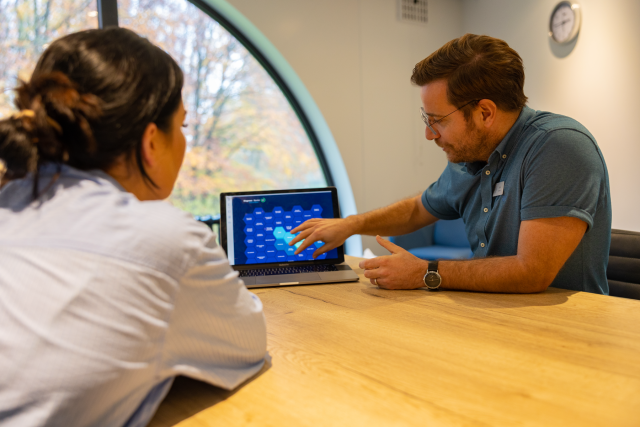-
About Hawking
- About Hawking ×
-
Our technology
- Our technology ×
-
EN
- Change language ×

Joris Vangeneugden is a psychiatrist at Yes We Can Clinics. From this role, he is one of the driving forces behind HoneyGrid™, part of the CareOS suite from Hawking.
Absolutely. In short, HoneyGrid provides a snapshot of a client's mental state. It assesses where someone is mentally. What someone is thinking about, how someone feels. For example, are delusions or hallucinations present? HoneyGrid is a fundamental part of the "Status Mentalis" examination. This examination forms the core of your task as a psychiatrist: gaining insight into the different aspects of a client's condition. On a cognitive level, conative level, affective level, impulse-driven level, and personality level. By completing the HoneyGrid, you create a snapshot of how someone is at a particular moment.

Just as a radiologist views and assesses an X-ray and an orthopedist examines a damaged knee, a psychiatrist studies the mental state of their patients. The examination method has always remained the same since the rise of psychoanalysts: purely verbal, very linguistic. The addition of HoneyGrid introduces a very visual layer to the examination. The snapshot I just mentioned. Because a picture says more than a thousand words, the essence of the examination surfaces much quicker. With just one glance, you can see what kind of person you have in front of you.
Instead of working with the diagnoses described in the DSM, HoneyGrid uses the transdiagnostic-based classification model of Bak, Domen, and Van Os. This model is based on symptoms, not diagnoses. It's a much more finely meshed system.
HoneyGrid is disruptive. Maybe not for the 7 billion people on Earth, but certainly within the community of psychiatrists, it will be a significant change towards other healthcare disciplines. It forms a new language with, for example, psychologists. You can compare it to maps: there are topographical maps, hydrographic maps, and topological maps, but the GPS coordinates mean the same thing in all these maps.
Absolutely. Risk assessment is another critical aspect of psychiatric examination. The way this is integrated into the entire workflow ensures an additional degree of thoroughness. This is also very valuable from a legal standpoint and for communication with the outside world. The system forces you to go through the entire risk analysis step by step, ensuring that you have asked everything and have confidently documented it. If you know that a client has expressed suicidal thoughts, but you haven't inquired and noted it in such a way, and then you hear about it afterwards, you might think, "Did I miss something here?"
"The entire HoneyGrid system beautifully guides you like an autopilot through all phases of the psychiatric examination."
HoneyGrid is very intuitive to use. It's effortless to handle. Depending on the severity, you can click on aspects relevant to a client once, twice, or thrice. The colours on the honeygrid then become more intense. Conversely, you can also decrease them if the symptoms lessen. The beauty is that all these snapshots are saved in a client's file, creating the timeline I mentioned earlier. So, with a few clicks of the mouse, you can see the evolution of the client's condition over time. Finally, you can share and review these snapshots with other caregivers.
The entire HoneyGrid system guides you beautifully like an autopilot through all phases of the psychiatric examination:
Phase 1 of this examination is obtaining the "first impressions." You note these within the system yourself.
Phase 2 is the HoneyGrid itself: What is the condition of the person sitting in front of you on cognitive, affective, and conative levels? How are their perceptual abilities? At this stage, you can easily adjust all symptoms up or down.
Phase 3 involves the risk factors. You map out these factors based on the visual representation created in phase 3. This is also important for the legal aspect associated with treatment.
Phase 4 is assessing the personality structure. At Yes We Can Clinics, we work with young clients (we call them fellows). These fellows are developing and forming their character. You may not and cannot make definitive statements about the personality structure of someone under 18. It has yet to crystallise. However, you do see that circumstances in the life of a minor play a role later when this person becomes an adult.
The ultimate goal, the holy grail, is to develop a system that provides insight into the complete psychological realm of a client—the X-ray of the mental state. HoneyGrid is a first step towards this.
For more information, you can visit this page. Of course, you are welcome to reach out to us. Call us at +31 (0)85 076 3000 or use our contact form.
Contact form